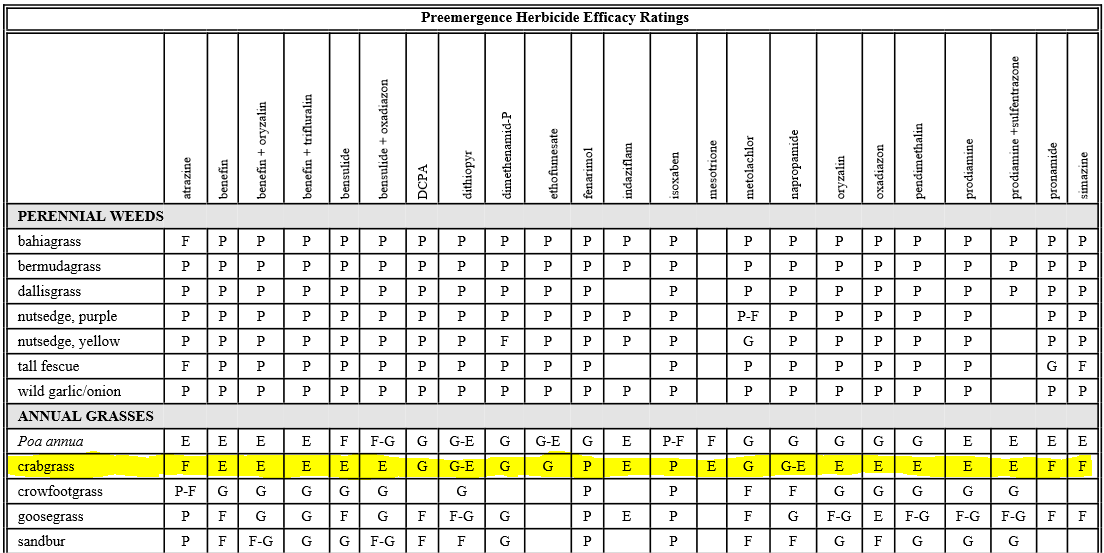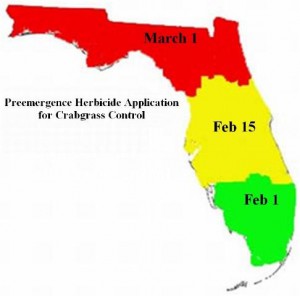
Immature crabgrass plant in turf. Photo credit: Crabgrass Biology and Management in Turf
Dr. Ramon Leon, Extension Weed Specialist, West Florida REC, Jay
So far this winter has been warmer than usual. If this trend continues, we will have weeds emerging early this spring. For this reason, it is a good idea to start thinking about the right time for preemergence (PRE) control against weeds in our sod. In general, PRE herbicides are the most common control tool for this purpose. There are multiple options depending on the weed species and the turfgrass species and cultivar. The University of Florida’s Pest Control Guide for Turfgrass provides a detailed description of herbicide alternatives, depending on the situation, as can be seen in this excerpt from the preemergence herbicide efficacy ratings chart.

The University of Florida’s Pest Control Guide for Turfgrass provides a detailed description of PRE and Post weed emergence herbicide alternatives for turgrasses. There is additional information that includes efficacy ratings for controlling broadleaf weeds as well. (click on the graphic to enlarge for easier reading)
For optimum results, it is imperative that PRE herbicides are applied before weed seeds start germinating. Although these herbicides do not kill weed seeds, many of them will only affect seedlings that have not yet emerged. Therefore, if the application of the herbicide is done after weed seed germination and seedling emergence have started, it is likely that many weed seedlings will not be killed, and they will cause problems during the spring. Also, it is important to remember that a moderate irrigation after the application will help placing PRE herbicides at the right depth within the soil to maximize their action.

Recommended preemergence herbicide application date under normal Florida weather conditions. Source: EDIS ENH1134
Not all weed species emerge at the same time. Their emergence timing depends on their temperature requirements for germination and growth. Crabgrass (Digitaria spp.) is a weed that can form dense populations within the turf, and for which control is more likely to be achieved using PRE herbicides than postemergence (POST) herbicides (https://edis.ifas.ufl.edu/ep395). Because this weed is one of the summer annual weed species that emerge first at the beginning of the year in Florida, it can be used as a reference for weed control timing early in the spring. Crabgrass will start germinating when the soil temperature is at least 50-55°F. For this reason, as a rule of thumb, it is recommended that PRE herbicide applications be done no later than February 1- South Florida, February 15 – Central, and March 1 – North Florida. However, if the winter is unusually cold or warm, applications can be delayed or rushed accordingly to make sure that the herbicide is applied before seed germination begins.
Properly timing PRE herbicide applications will provide a cleaner environment during the spring helping the turf to form a denser canopy that will shade late emerging weeds simplifying weed management during the spring and summer.
For more information about herbicide options in turgrasses visit:
Crabgrass Biology and Management in Turf
Weed Management Guide for Florida Lawns
UF/IFAS Turfgrass Science website: http://turf.ufl.edu
- Palmer Amaranth Adaptability - March 10, 2017
- Helping Turfgrass Overcome Herbicide Injury - October 7, 2016
- Challenges for Use of Glyphosate Alternatives in Urban Landscapes - May 27, 2016
